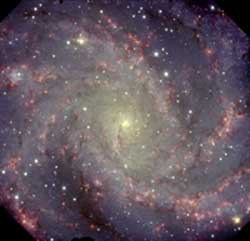A stellar debut for Gemini Observatory’s online image gallery

Gemini North GMOS image of the “Fireworks Galaxy” NGC 6946 which straddles the boundries between the constellations of Cepheus and Cygnus.
To celebrate the New Year – and to mark the formal debut of its online Image Gallery – the Gemini Observatory has released three striking new images.
The first, taken by the Gemini North telescope atop Mauna Kea on the big island of Hawaii, was made public on New Year’s Eve, 2004, and shows the face-on spiral galaxy NGC 6946 ablaze with galactic fireworks. Each explosion of pink is a region of active star formation, where the fierce light of newborn stars is exciting the surrounding hydrogen gas into incandescence. In addition, the fiercest and most massive of these stars have been burning themselves out and ending their lives in an even more spectacular fashion – by detonating in a string of cataclysmic, rapid-fire supernova explosions. Astronomers have observed eight supernovas in this one galaxy in the past 100 years, as opposed to just four in our own galaxy in the past 1000 years, and they suspect that the supernovas have been going off at that rate for tens of millions of years.
Indeed, for reasons that are still not clear, NGC 6946 is among the most prolific galaxies known for star birth and star death alike.
The other two images images were released today at the 205th meeting of the American Astronomical Society in San Diego. Both were obtained on December 5, 2004, by the Gemini South telescope at Cerro Pachón in Chile, and will join the more than 100 images already available in the observatory’s Image Gallery.
One shows a pair of interacting galaxies located about 55 million light-years from Earth in the direction of the southern constellation of Eridanus. The larger of the two, NGC 1532, is a spiral galaxy much like our own Milky Way. Seen nearly edge-on, its dusty spiral arms, lined with reddish star-forming regions in the foreground, are silhouetted against the galactic disk. Likewise, the smaller galaxy, NGC 1531, resembles our galaxy’s biggest companion, the Large Magellanic Cloud. Hints of interaction between these galaxies are seen in at least two stray associations of stars, and glowing red clumps of hydrogen gas.
The last image shows NGC 2467, one of the Milky Way’s most active stellar nurseries. Located in the southern constellation of Puppis, NGC 2467 illustrates many phases of star birth at once. In the lower right, the brilliant light of newborn stars causes the surrounding gas to glow and evaporate, revealing knots of denser gas and dust where an even younger generation of stellar siblings is about to be born. The dust lanes and dark globules of gas in the center are left over from an earlier burst of star formation. The cluster of slightly older stars to the left emerged from the region several million years ago.
In addition to housing many views of astronomical objects, the Gemini Image Gallery contains downloadable posters, illustrations, videos and animations, as well as multiple images of the twin telescopes themselves.
Media Contact
All latest news from the category: Physics and Astronomy
This area deals with the fundamental laws and building blocks of nature and how they interact, the properties and the behavior of matter, and research into space and time and their structures.
innovations-report provides in-depth reports and articles on subjects such as astrophysics, laser technologies, nuclear, quantum, particle and solid-state physics, nanotechnologies, planetary research and findings (Mars, Venus) and developments related to the Hubble Telescope.
Newest articles

Pinpointing hydrogen isotopes in titanium hydride nanofilms
Although it is the smallest and lightest atom, hydrogen can have a big impact by infiltrating other materials and affecting their properties, such as superconductivity and metal-insulator-transitions. Now, researchers from…

A new way of entangling light and sound
For a wide variety of emerging quantum technologies, such as secure quantum communications and quantum computing, quantum entanglement is a prerequisite. Scientists at the Max-Planck-Institute for the Science of Light…

Telescope for NASA’s Roman Mission complete, delivered to Goddard
NASA’s Nancy Grace Roman Space Telescope is one giant step closer to unlocking the mysteries of the universe. The mission has now received its final major delivery: the Optical Telescope…



